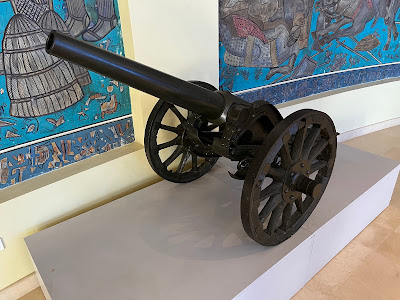I am in Romania this week for my annual Balkan-related tour. I hadn't been for 20 years when I focused on Transylvania. So, to tie in with research for my current book project, I decided to go east into Moldavia.
I flew from London and hired a car at the airport. The first stop was the Battle of Rymnik, fought on 22 September 1789, during the Russo-Ottoman War of 1787-92. The Russian general Alexander Suvorov and the Habsburg general Prince Josias of Coburg attacked the main Ottoman army under Grand Vizier Cenaze Hasan Pasha. I'll be writing more about this battle soon, but let's just say it is complicated for now.
Finding the key actions on the ground is challenging when working off an 18th-century map with no orientation and a limited idea of scale. Then the terrain changed enormously, with the marshes drained, the woods gone, and the rivers almost waterless. However, it has one redeeming feature, a magnificent statue of Suvorov gazing down on the battlefield. The statue was initially close to his river crossing, but that is a bit out of the way, as I discovered, so they moved it. The plinth is still on the high ground above the Rymna River; although guarded by a pack of dogs. I showed less than Suvorov-type courage.
The next stop was the Battle of Foscani, fought on 1 August 1789. Different Grand Vizier, they came and went at speed in this period! but Suvorov again. My map was somewhat better, but all the same challenges, plus urban sprawl all over the Ottoman trenches. It is also dead flat farmland terrain, so there is nothing to see.
The area is known as the Foscani Gap, defending Romania from the Carpathians to the Danube. It was fortified in the late 19th century when they expected Russia to invade. However, it had to be reversed in WW1. There were battles with the Germans and Austrians, but with Russian help, Romania held on. This is all remembered in a fine mausoleum and museum at Mărășești. The museum is small but has some rare exhibits
 |
| 53mm Gruson Cannon |
 |
| Russian Maxim |
 |
| Russian, Nevsky trench mortar |
My final stop was the Battle of Târgu Frumos. In 1944, the Germans and Romanians fought the Soviets in several battles. In particular, Hasso von Manteuffel's Großdeutschland Panzergrenadier division fought a model mobile defence still taught in military academies today. Unsurprisingly, there is nothing to mark the battle.
I stayed overnight in Iasi to have dinner with a production company that wanted historical advice on a potential TV series about Western Europeans who have influenced the Balkans. These things often don't get far, but we will see. Later, I was pitching again for Auguste Marmont in the Napoleonic Wars podcast's Battle of the Marshals. He would certainly get on the Balkan shortlist.








No comments:
Post a Comment